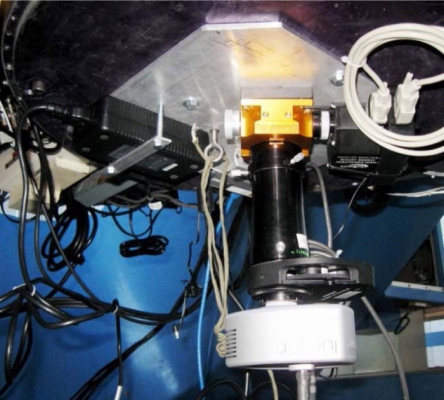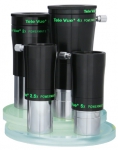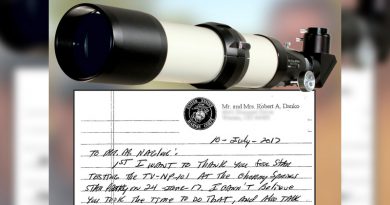TELE VUE SCIENTIFIC PART 3
+ New Product Announcement!

In this installment, we travel to Kitt Peak in the Arizona-Sonoran Desert to “speckle” binary stars and finally learn what the impressive-sounding Bundesdeutsche Arbeitsgemeinschaft für Veränderliche Sterne group does! (If you missed our prior Tele Vue Scientific installments, you can click to read Part 1 and Part 2).

Introduction Often practiced by amateur astronomers doing planetary work, “lucky” imaging was invented by professional astronomers to try to “freeze” distortion of starlight passing through our planet’s turbulent atmosphere. This is done by taking many short exposures of a target, instead of one long one. Amateurs usually align and stack the best quality photos to create an image. Professionals use their data to perform speckle interferometry involving complex math. Speckle interferometry is useful in refining the orbits of close binary stars. The introduction to a 2014 paper, “Kitt Peak Speckle Interferometry of Close Visual Binary Stars,” explains how this works.
The resolutions of conventional visual binary observations were seeing limited until Labeyrie (1970) devised speckle interferometry as a way to circumvent seeing limitations and realize the full diffraction-limited resolution of a telescope. The light from a close binary passing through small cells in the atmosphere produces multiple binary star images which, if observed at high enough magnification with short exposures (typically 10 to 30 milliseconds), will “freeze” out the atmospheric turbulence and thus overcome seeing-limitations. Although the multiple double star images are randomly scattered throughout the image (often superimposed), their separation and position angle remains constant, allowing these two parameters to be extracted via Fourier analysis (autocorrelation).
The paper says that this technique, made practical with the introduction of the CCD camera, resulted in an order of magnitude improvement in binary star data measurement over visual observations. Speckle interferometry then became the preferred technique for characterizing close binary stars.

Their gear was also an eclectic mix of products from the amateurs and professional worlds. It consisted of an Oxford Instruments, Andor Technologies, front-illuminated, Luca-R camera with Orion 5-Position filter wheel connected to a 2″ Tele Vue 4x PowerMate installed into a Moonlite Crayford focuser with a 2″ OPT (TPO) 2x Barlow on the other side of the focuser (to extend the focal plane out to the rest of the optics). This system was installed at the f/7.6 Cassegrain focus of the 2.1-meter Ritchey–Chrétien telescope at the Kitt Peak National Observatory.
Conclusion The first nine-night data run amassed 1.4 terabytes of FITS image data! Among the conclusions was verification that the system was effective for observing close binaries, down to 0.1 arcseconds apart, with the 2.1-m telescope.
The first results on a specific target were published by a team of advanced placement high school students (Adam et al., 2014a). They found that the published orbit of binary system WDS 01078+0425 / BU 1292 was 282.1 years — which was less than the previously published orbit by 3.2 years.


One proficient group of BAV authors is Peter Frank, Wolfgang Moschner, and Klaus Bernhard. Their copious achievements, published in the journal include discovering new variable stars and refining the orbital elements of eclipsing binaries. They do this by imaging stars over long periods of time. Light curves are then generated from their images with C-Munipack software available on SourceForge.net.
Team member Peter Frank (Velden, Germany) uses a Tele Vue-102 with SIGMA 1603 CCD-camera (Kodak KAF1603ME chip) for this research and is often credited with discovering new variables. Additional observations are done with a 400mm ASA Astrograph located in Nerpio, Spain, and operated by Wolfgang Moschner.
The year 2021 is able to squeeze in four full Moons over the three months of the summer season. They are:
-
- June 24th: Strawberry Moon
- July 23rd: Buck Moon
- August 22nd: Sturgeon Moon
- September 20th: Harvest Moon
- Learn the “secret” of why scientists use Tele Vue telescopes on our Tele Vue APO Design and Build “Secrets” blog post.
- Our Powermate page describes how this amplifier can be used for visual and imaging applications (mobile site).






